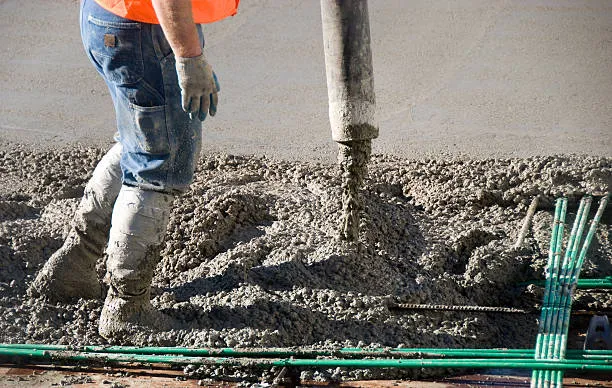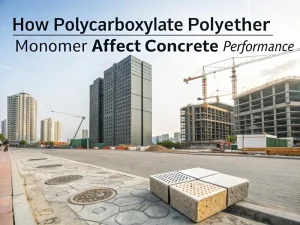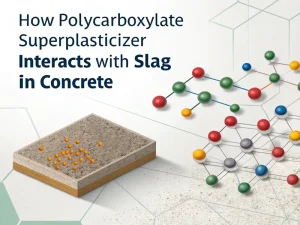Blog
At any construction site, you may hear workers discussing the “feel” of concrete – whether it is too dry, too hard, or just right. This’ feeling ‘is referred to as workability in professional terminology. The concrete with poor workability is like a bowl of too-thick oatmeal Congee, which is challenging to mix, spread, and ensure the final product quality.
So, what should we do when the concrete is too dry and hard? Although the most intuitive reaction is to “add some water”, it is taboo in professional construction because it will seriously weaken concrete’s final strength and durability.
Fortunately, modern chemistry provides the perfect solution for this: an admixture specifically designed to increase the workability of concrete.
This article will delve into this critical additive, explaining what it is, how it works, and why it is crucial for modern architecture.

Workability refers to the ease with which fresh concrete can be mixed, transported, formed, and completed without segregation or bleeding. High workability makes concrete easier to handle and pour, especially in complex forms or structures with dense steel reinforcement.
It describes the ease of handling of fresh concrete, covering the following aspects:
Mixability: Whether the components can be easily and evenly mixed.
Transportability: Whether it can maintain uniformity and prevent separation during transportation.
Placeability: Can it be easily poured into the template?
Compactability: Can the air inside be easily expelled through vibration to achieve a compact state?
Finishability: A smooth and even surface can be easily obtained.
Water-reducing agents are the most common solution for improving workability. They reduce the water-cement ratio (w/c) to enhance the flowability of concrete with less water usage, or to maintain workability with the same moisture content.
How they work:
WRA molecules cover cement particles, generating electrostatic repulsion and decomposing clumps. This releases the trapped water, making it more efficient to lubricate the mixture.
Type:
Conventional WRA: reduces water consumption by 5-15%, which is very suitable for residential slabs, beams, and general buildings.
The new generation of polycarboxylate superplasticizers can reduce water by 15-40%, making large projects (such as skyscrapers, bridges) or self-compacting concrete (SCC) highly flexible.
Plasticizers are a subset of water-reducing agents that enhance fluidity without adding additional water. They are milder than high-efficiency water-reducing agents, but adequate for moderate processability requirements.
How they work:
Like WRA, plasticizers disperse cement particles to reduce friction, making the mixture smoother and easier to pour. They usually reduce moisture by 5-15%.
Use:
Residential buildings, hand-poured concrete, and mixtures must minimize moisture to avoid losing strength.
Example: Adding 1% plasticizer to a complex mixture can turn it into a pourable consistency for use on backyard terraces or driveways.
The air entraining admixture will generate small and stable bubbles (1-8% of the concrete volume), acting as “ball bearings” between particles, improving workability and freeze-thaw resistance.
How they work:
Bubbles reduce friction between aggregates, making the mixture more fluid. They can also minimize bleeding (water separation) and segregation, keeping the mixture uniform.
Best suited for:
Cold-weather projects (roads, sidewalks) where freeze-thaw resistance is crucial, as well as lightweight concrete or mixtures containing complex aggregates.
Fly ash is a byproduct of coal combustion, serving as both a substitute for cement and an enhancer of workability.
Working principle:
Its spherical particles lubricate the mixture, reducing friction. It also slows down the hydration of cement and prolongs its workability under hot weather conditions.
Advantage:
Replace 15-30% of cement, reduce costs and emissions, while improving flow rate. Very suitable for large volume concrete (dams, foundations), whose workability must last several hours.
GGBS is a byproduct of iron production, a fine powder that can improve processability and long-term strength.
Working principle:
GGBS particles fill the gaps between cement particles to reduce friction. It can also delay solidification and extend processability – very suitable for large-scale casting or hot climates.
Use:
High-performance concrete, marine structures, and projects that require extension and workability (such as precast concrete production).
Evaluate project requirements: Ordinary plasticizers or WRA are sufficient for small and simple casting. For complex shapes or SCC, superplasticizers are essential.
Consider climate: Mix workability additives with retarders in hot weather to prevent premature setting. In cold weather, avoid excessive entrainment of air (which can weaken the concrete).
Testing compatibility: Some additives (such as fly ash+high-efficiency water reducing agent) work together, while others may conflict – test small batches first.
Avoid excessive use: Excessive additives can cause segregation (separation of aggregate and slurry) or excessive bleeding.
Control moisture content: Admixtures improve workability without adding additional water – adding more water will weaken the concrete.
Adequate mixing: Ensure even distribution of admixtures to prevent uneven flow.
Time is ripe: Add high-efficiency water-reducing agents after initial mixing to achieve optimal dispersion, especially in high-strength mixtures.
Choosing appropriateadmixture to increase workability of concrete is crucial for achieving high-quality, durable, and easy-to-handle mixtures. Whether using water reducing agents to increase strength and flow rate, plasticizers to meet moderate demand, or air entraining agents to cope with cold climates, these additives are essential for modern buildings. This additive has become indispensable to modern concrete technology in today’s pursuit of higher quality and more complex building designs.

How Polycarboxylate Polyether Monomer Affect Concrete Performance
Blog How Polycarboxylate

How Polycarboxylate Superplasticizer Interacts With Slag In Concrete
Blog How Polycarboxylate